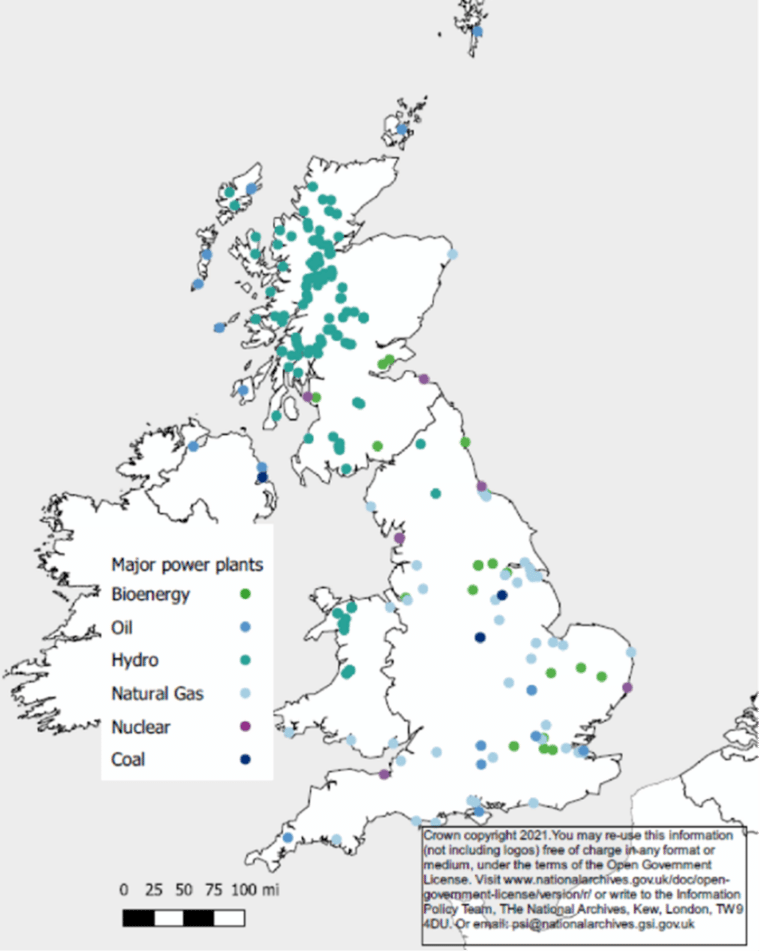Data Summary – Solid Biomass consumption trends in the UK energy sector 2016-2021
- Demand for solid biomass has risen dramatically over the last decade, principally driven by the power sector.
- In 2021 biomass power became the third largest contributor to UK electricity generation
- The majority of plant biomass has derived from imported material, predominantly in the form of wood pellets, but domestic biomass production has also seen a dramatic increase.
The utilisation of solid biomass as a fuel in generation of heat and power has seen a significant increase over the last ten years as many coal-fired power stations converted to using biomass. This article provides a summary of the data reported by BEIS and OFGEM specific to solid biomass use in the UK heat and power sector over the last 5-10 year period.
The role of bioenergy in UK energy generation
The Department for Business Energy and Industrial Strategy (BEIS) publish an annual digest of UK Energy Statistics (DUKES). Data is reported in terms of million tonnes of oil equivalent (Mtoe). The report published in 2022 stated that bioenergy and waste on average contributed 10% of the total energy generated in the UK in 2020 and 2021. Increase in the output from bioenergy and waste was in part due to reductions in output from fossil fuels, nuclear power and outputs from wind, solar and hydro power which were affected by less favourable conditions during this period.
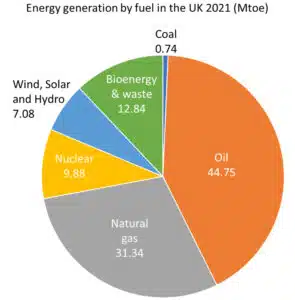 Energy from bioenergy and waste was the fourth largest contributor to UK energy generation in 2021. Predominantly through large-scale electricity generation.
Energy from bioenergy and waste was the fourth largest contributor to UK energy generation in 2021. Predominantly through large-scale electricity generation.
Biomass also contributed to generation via a network of around 2,000 smaller combined heat and power (CHP) facilities which are designed to enable use of both electricity and heat from fuel conversion. Co-generation can improve efficiency by up to 20% compared with electricity generated without heat recovery. CHP schemes accounted for 7% of the total electricity generated.
In 2021, CHP schemes were predominantly fuelled by natural gas with solid biomass, biogas and waste contributing (6.3%, 8.2% and 5.6% respectively).
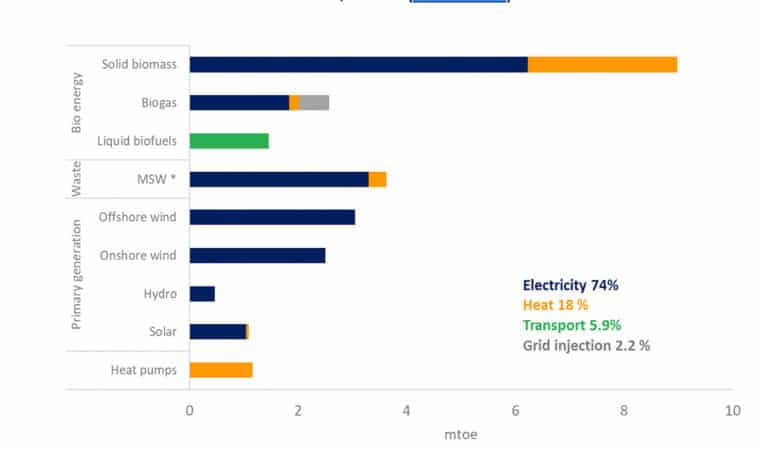
Source: DUKES, 2022
Solid biomass (wood, waste wood, animal and plant biomass) accounted for 36% of the renewable energy output in 2021. Two thirds of the energy generated from solid biomass was used for electricity and a third for generation of heat.
Solid Biomass in UK Energy Generation – The overall trend 2010 – 2021
The rise in the use of solid biomass has principally been driven by electricity generation. The data reported in DUKES shows the steep rise in use of plant biomass from 2010- 2021 in terms of thousand tonnes of oil-equivalent. Plant biomass is differentiated from wood in this data as the plant biomass category includes a wide range of solid biomass materials. The majority has been composed of forestry or timber processing residues which are differentiated from wood as they have been further processed in some way, such as by milling, pelletisation or chipping.
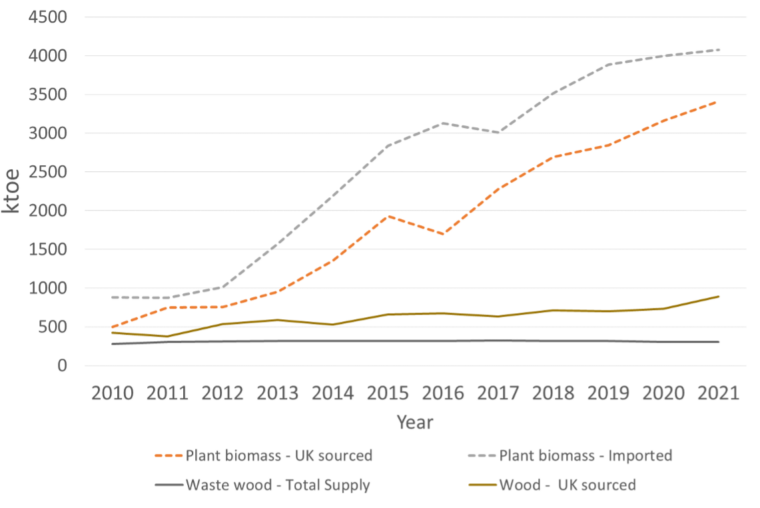
Solid Biomass used for energy generation 2010 – 2021 in thousand tonnes of oil equivalent (DUKES, 2022)
The majority of plant biomass used in electricity generation has derived from imported material, predominantly in the form of wood pellets. UK plant biomass supply has also increased significantly, predominantly in the form of wood chip from forest residues.
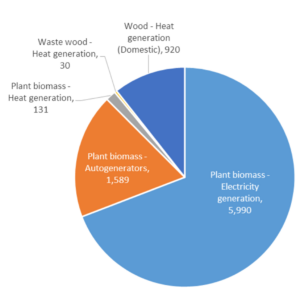
Solid Biomass used for energy generation 2020 – 2021 in thousand tonnes of oil equivalent (DUKES, 2022)
The wood supply quoted in the DUKES data refers to the use of traditional firewood, principally for domestic heating applications, which has also seen a small increase in uptake over the last ten-year period. Waste wood e.g. wood derived from previous industrial uses or recycled material, has also made a small but consistent contribution to energy generation.
Of the total solid biomass used for energy generation in 2020-21, the use of plant biomass for electricity generation was the largest single contributor, accounting for 69% of the total use. Plant biomass used in combined heat and power systems (CHP or autogenerators) was the second largest contributor (18%) followed by the domestic use of wood for heating which contributed 11% of the total biomass converted.
Type, form and origin of Biomass used in UK energy generation
The Renewables Obligation (RO) was designed to incentivise large-scale renewable energy generation in the UK and is administrated by OFGEM. Data regarding what biomass is being used, the quantities consumed, and its’ origin is collected and made available by OFGEM annually. Accredited power generators receive payments from the government in return for certificates (ROCs) which are obtained for roughly every megawatt (MW) of energy generated from renewable sources. In response to concerns regarding sustainability, RO Sustainability criteria were introduced in 2015/16 which must be reported against in order for generators to qualify for ROC payments. Current guidance requires generators with outputs exceeding 50 kW to submit monthly reports to verify compliance with RO sustainability criteria except for generators using sewage or landfill gas, municipal waste, or biomass with a biogenic content <90%.
Forms of biomass being used in UK Energy generation 2020-2021 as reported in Renewables Obligation Biomass Sustainability profile datasets.
Based on the data from the OFGEM biomass sustainability dataset profile data for 2020-2021; includes all reported consignments, facilities with outputs, grouped by feedstock type and form. The data presented refers solely to biomass used in combustion applications and does not include anaerobic digestion. Data is presented in thousand metric tonnes (kt).
| Wood | 7,829 | Miscanthus | 44 | |
| Pellets | 4,747 | Bales | 44 | |
| Chip | 2,532 | Pellets | ||
| Logs | 550 | Willow SRC | 19 | |
| Chip | 19 | |||
| Waste Wood | 2,732 | Sewage sludge | 17 | |
| Chip | 2,214 | Sludge | 17 | |
| Bulk material | 517 | |||
| Straw | 896 | Animal residues | 260 | |
| Bales | 896 | Solid mass | 260 | |
| Agricultural residues | 755 | Other residues | 84 | |
| Solid mass | 602 | Sludge | 62 | |
| Pellets | 153 | Grains | 22 |
Wood pellets, produced from a mixture of virgin timber, forest and process residues represent the largest share of the biomass consumed in the heat and power sector. Wood chip from timber, residues and waste-wood are the second major contributor of biomass material. Several power stations are designed to run on bailed material, principally cereal straws, but can also process bales of other biomass types (miscanthus & agricultural residues).
A full breakdown of the data is provided in the accompanying PDF document. Click here to download the Biomass Connect Technical Article: “Data Summary – Solid Biomass consumption trends in the UK energy sector 2016-2021” [PDF – 452 KB]
